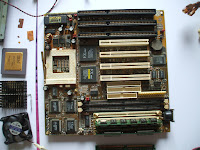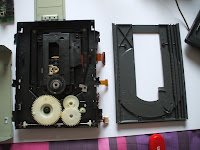The aim of this project is to make a book that explains how computers work in a way everyone can understand. I plan to do this by...
- Using as little jargon as possible
- Using tangible mechanical metaphors and diagrams to explain the complex
- And breaking down the computer into its basic parts
One thing I imagine the many future readers of this book will think about is how does everything I explain relate to the actual thing. In other words, what's actually going on inside all those microchips? No metaphors. Show me what's actually going on. It's like people wanting to see the explosions inside an internal combustion engine.
This is the biggest challenge of this project. Computers work using electricity, and electricity is invisible (apart from when you apply too much current or voltage to a device). So a small crash course on the subject will be included in the book. But they still demand seeing actual components at work, so my diagrams will have to look like the actual insides of a computer as possible.
However, they will be some who have never taken a screwdriver to a computer before. Those who have always obeyed the "warranty void" stickers. I know some books have shown the insides of computers before, but have they seen them? Did they do a good job explaining their parts for those who have?
I thought it would be a good idea to actually take apart a computer for those readers..... and I did.
What you'll see above is an old Windows PC my late dad owned in the mid-1990s. Judging from labels on the components it was made in 1995 and was then upgraded in 1997 (it had two hard drives. One 450MB one (which it originally had) and a 3.49GB one that was added later on). I have memories playing games, exploring CD-ROMs and using CorelDRAW 4 and Kid CAD on this very machine. It was buried under some junk when I found it a while ago. (The later Windows PC he bought in 2000 to replace it was thrown into a skip in 2016. I know because I was the one who lifted it to that skip.)
I thought a PC from this vintage would be the ideal choice for dismantling for the readers. This may be due to me seeing computers of this vintage dismantled in books from about the same time...
The inside of an Apple Macintosh IIcx
from DK Dictionary of Science (1994)
But, after thinking about it, a 1990s desktop is ideal for my book. A PC today may be light years away from a 90s desktop, but inside they look very similar. It's like the transmission in a modern car is not that different of that found in a Ford Model T. This would help with one of the main points of my book - all computers (from the 1930s to now) work exactly the same way. They may use different technologies to do some things, like valves or floppy disks, but the principles behind them are the same.
It was in the 90s when PCs really became mainstream devices, after killing its many rival incompatible systems, leading to today's industry of build-it-yourself PCs. Similar to what happened when the Model T became popular in the 1910s. Ford made a car that was simple, to make it easy to mass-produce, use and maintain. Other cars at the time were too complicated than they should have been, which made most drivers employed chuffers - kind of like the specialists that were once the only people who could use computers.
The dismantling of the ancient PC was an adventure of curiosity. It was something that showed how willing I am to do research on a subject, if a project requires it. Here's more photos of my research.
Those last two pics were of the PC's CD-ROM drive. Dismantling that drive was a challenge on its own.
The plan is to turn my observations into a large drawing of a computer's inners, like the one at the top of this post. I've already drawn and mocked up prototypes of the pages featuring this drawing.
The latter one is close to what the final version is going to be like. Note that I include the wires in it and took the components out of the metal casing (the grey rectangle at the bottom).
Since I first told you about this project back in 2016 I have read and watched a lot of research material, made a lot of sketches, and wrote up some text for it.
The dismantling of the old PC this week is the beginning of phase one.


















No comments:
Post a Comment